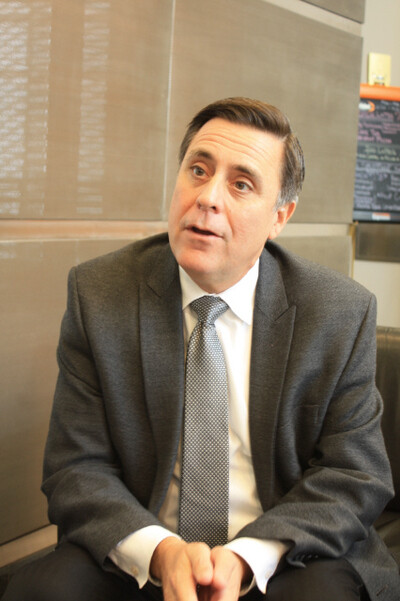hankyoreh
Links to other country sites 다른 나라 사이트 링크
South Korea’s pyroprocessing is not proliferation-proof, official says

"Pyroprocessing cannot be said to completely prevent nuclear proliferation, but I do think that it’s not proliferation-proof, but it’s proliferation resistant. It’s marginally more proliferation-resistant than PUREX processing,” said Mark Peters, associate director of the Argonne National Laboratory, a nuclear physics research institute that is affiliated with the US Energy Department, in an interview with South Korean reporters on Oct. 28. US and South Korea are jointly researching the pyroprocessing technology at the laboratory
Proliferation resistance is a technical term that signifies the ability to prevent nuclear proliferation. Peters’ comments mean that adopting the pyroprocessing technique will not stop nuclear proliferation.
Pyroprocessing and PUREX are techniques that recover the uranium in spent nuclear fuel and enable it to be “recycled” as the nuclear fuel in fast reactors.
While the PUREX (plutonium-uranium extraction) process can enable nuclear proliferation by producing pure plutonium, which is the raw material for nuclear weapons, the South Korean government and some members of the nuclear power industry claim that pyroprocessing hinders or even prevents nuclear proliferation because it does not separate out plutonium.
On these grounds, the South Korean government is asking the US government to allow it to reprocess spent nuclear fuel through pyroprocessing in the revision to the ROK-U.S. Atomic Energy Agreement, which is supposed to be reached within the year. However, the US government has been opposed to the idea because of concerns about the possibility of this fuel being used to make nuclear weapons.
In 2010, the Argonne National Laboratory began a 10-year joint research process on pyroprocessing with the Korea Atomic Energy Research Institute. In 1994, the institute was forced to end a previous 10-year research initiative on the topic because of US government policy.
When asked whether the results of a study on the proliferation risk of pyroprocessing that was carried out at Argonne National Laboratory and six other national laboratories in 2009 were still valid, Peters said that they were.
According to the 2009 study, pyroprocessing and other alternative technologies only show a small improvement in reducing the risk of nuclear proliferation. It also concluded that even this improvement mostly applies to non-state actors. This implies that the effect is negligible for countries.
This view is also affecting negotiations about revising the US-Korea nuclear agreement. In regard to the question of allowing pyroprocessing, discussion is reportedly taking place about maintaining the clause in the main text that requires “prior consent” from the US - which has functioned as an effective ban - while revising the implementation annex to allow pyroprocessing for research and development on a conditional basis.
“The conditions are complex,” one source said, suggestion that the US means to impose strict conditions on South Korea.
By Park Hyun, Washington correspondent
Please direct questions or comments to [english@hani.co.kr]

Editorial・opinion
![[Column] Has Korea, too, crossed the Rubicon on China? [Column] Has Korea, too, crossed the Rubicon on China?](https://flexible.img.hani.co.kr/flexible/normal/500/300/imgdb/original/2024/0419/9317135153409185.jpg) [Column] Has Korea, too, crossed the Rubicon on China?
[Column] Has Korea, too, crossed the Rubicon on China?![[Correspondent’s column] In Japan’s alliance with US, echoes of its past alliances with UK [Correspondent’s column] In Japan’s alliance with US, echoes of its past alliances with UK](https://flexible.img.hani.co.kr/flexible/normal/500/300/imgdb/original/2024/0419/2317135166563519.jpg) [Correspondent’s column] In Japan’s alliance with US, echoes of its past alliances with UK
[Correspondent’s column] In Japan’s alliance with US, echoes of its past alliances with UK- [Editorial] Does Yoon think the Korean public is wrong?
- [Editorial] As it bolsters its alliance with US, Japan must be accountable for past
- [Guest essay] Amending the Constitution is Yoon’s key to leaving office in public’s good graces
- [Editorial] 10 years on, lessons of Sewol tragedy must never be forgotten
- [Column] A death blow to Korea’s prosecutor politics
- [Correspondent’s column] The US and the end of Japanese pacifism
- [Guest essay] How Korea turned its trainee doctors into monsters
- [Guest essay] As someone who helped forge Seoul-Moscow ties, their status today troubles me
Most viewed articles
- 1[Column] The clock is ticking for Korea’s first lady
- 2[Column] Has Korea, too, crossed the Rubicon on China?
- 3After 2 months of delayed, denied medical care, Koreans worry worst may be yet to come
- 4US overtakes China as Korea’s top export market, prompting trade sanction jitters
- 5[Editorial] When the choice is kids or career, Korea will never overcome birth rate woes
- 6[Correspondent’s column] In Japan’s alliance with US, echoes of its past alliances with UK
- 7Hong Se-hwa, voice for tolerance whose memoir of exile touched a chord, dies at 76
- 8Nearly 1 in 5 N. Korean defectors say they regret coming to S. Korea
- 9John Linton, descendant of US missionaries and naturalized Korean citizen, to lead PPP’s reform effo
- 10Strong dollar isn’t all that’s pushing won exchange rate into to 1,400 range